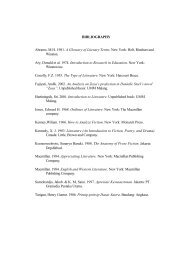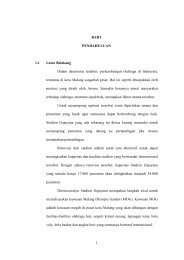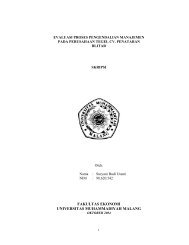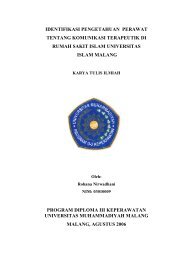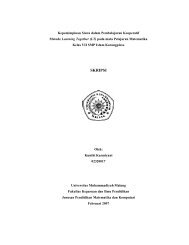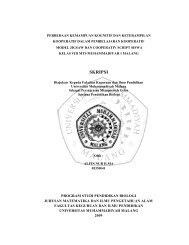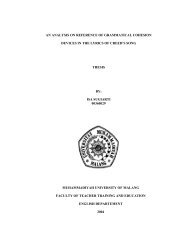File : THESIS.pdf - Universitas Muhammadiyah Malang
File : THESIS.pdf - Universitas Muhammadiyah Malang
File : THESIS.pdf - Universitas Muhammadiyah Malang
You also want an ePaper? Increase the reach of your titles
YUMPU automatically turns print PDFs into web optimized ePapers that Google loves.
(g) use the knowledge gained in this section in new situations or to solve related problems.<br />
Applications of Biology<br />
BIOLOGY 9700 A/AS LEVEL<br />
Q BIODIVERSITY AND CONSERVATION<br />
Content<br />
Classification<br />
Conservation<br />
issues Learning<br />
Outcomes Candidates<br />
should be able to:<br />
(a) *outline the five kingdom classification to illustrate the diversity of<br />
organisms (cross reference Syllabus Section A (c) and A (g));<br />
(b) discuss the meaning of the term biodiversity;<br />
(c) discuss the reasons for the need to maintain biodiversity;<br />
(d) describe the reasons why one named species has become endangered,<br />
and use this information in the context of other endangered species;<br />
(e) discuss methods of protecting endangered species including the<br />
roles of zoos, botanic gardens, conserved areas (national parks) and<br />
seed banks;<br />
(f) use the knowledge gained in this section in new situations or to<br />
solve related problems.<br />
R GENE TECHNOLOGY (includes some material originally in Section O)<br />
Content<br />
Gene technology for insulin production<br />
Markers for genetic engineering<br />
Benefits and hazards of gene<br />
technology DNA sequencing and<br />
genetic fingerprinting Cystic Fibrosis<br />
Genetic screening and genetic counselling<br />
Learning Outcomes<br />
Candidates should be able to:<br />
(a) describe the steps involved in the production of bacteria capable of<br />
synthesising human insulin:<br />
• identifying the human insulin gene<br />
• isolating mRNA and making cDNA using reverse transcriptase<br />
• cloning the DNA using DNA polymerase<br />
• inserting the DNA into a plasmid vector using restriction enzymes<br />
and DNA<br />
ligase<br />
• inserting the plasmid vector into the host bacterium<br />
• identifying genetically modified bacteria using antibiotic resistance<br />
genes<br />
• cloning the bacteria and harvesting the human insulin<br />
119



